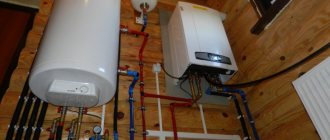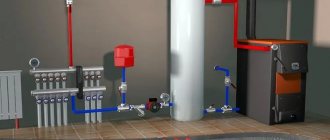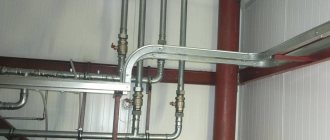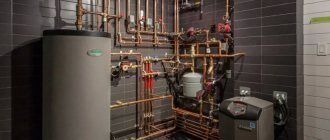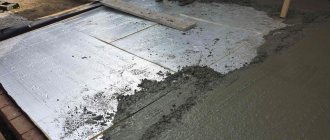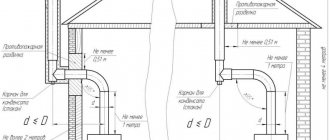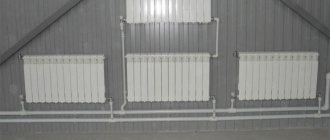Operating principle of a steam boiler
Design of a steam boiler
The operation of steam boilers is based on heating water until it reaches the boiling point. After this, it transitions to the vapor state. The whole process is carried out by controlling the water level in the boiler and the formation of evaporation.
The volume of water is controlled using sensors. When the boiler starts, the feed pump starts working. It pumps liquid into the heating zone. As soon as the burner turns on, the water begins to heat up and evaporation occurs.
After the water volume has evaporated, the feed pump starts working again. It operates until the level reaches the operating level. The whole operating principle is based on cyclicity. In addition to working levels, there are also emergency levels. They work as soon as the pressure rises.
Features of steam heating
Under the influence of constant pressure, water boils, its temperature always remains constant. As a result of boiling, steam is formed, which releases a large amount of thermal energy. When condensation occurs, thermal energy is released into the environment.
A steam heating system operates on this principle. The water in the boiler boils, steam begins to move through the radiator and pipes. Heat is released there, due to which the air in the room is heated.
As a result of condensation, water is formed, which continues to move through the pipes. It returns to the storage tank, then with the help of a pump it goes to the heater.
Advantages and disadvantages
Steam heating is effective for both large and small rooms. The temperature in the room rises very quickly. This is an undoubted advantage. The pipeline diagram does not need to be complicated by installing radiators: pipes carrying hot steam will suffice.
- Steam heating can be installed in country houses and winter houses. If there is no need for heating, the boiler is simply turned off. The highway will not defrost.
- The cost of installing heating, ease of maintenance and operation are attractive.
- If it is possible to connect to the central gas main, then purchase a gas boiler, which will save the home owner’s finances.
Despite the advantages inherent in steam heating, it also has disadvantages. There is always a risk of an emergency. If you choose the wrong equipment or install the line poorly, steam under pressure can rupture the pipe or radiator.
Household members or animals may suffer severe burns. To install equipment, they always turn to specialists to avoid emergency situations.
YouTube responded with an error: The request cannot be completed because you have exceeded your quota.
Types of steam boilers
Solid fuel model
Steam boilers are classified depending on the type of fuel used.
Solid fuel
Depending on the type of material used to operate the boiler, the devices are equipped with different combustion chambers. Steam boiler houses most often use coal, peat, and wood waste as fuel. Industrial boilers operate on this principle. Their main disadvantage is environmental pollution and a higher fire hazard class.
Industrial steam boilers operating on solid fuel are distinguished by their high power and large dimensions. They are used for the food, textile and processing industries.
Electrical
A steam boiler powered by electricity has found wide application in everyday life. The structure is equipped with a steam generator, a pump, and a cabinet for energy conversion.
Gas
A steam-water boiler is the most budget option. Its main advantage is its high degree of efficiency. Structures operating on the principle of condensation can be used for heating and for domestic needs.
Electric
Gas
Main components
The key component of the system is the boiler. Its main purpose is to convert water into steam. Later it goes into the pipeline.
The boiler must be powerful enough to pull two floors at the same time
The design elements here are:
- pipe system;
- collectors;
- drum.
A container of water is also required. It is called the body of water. There is a special means of evaporation here, which plays the role of a separating element.
Steam space
Additional equipment can be installed here. It can be useful if steam separation is required. Intensive exchange between steam and water is the basis of boiler operation. Heating devices are divided into water- and fire-tube. In the latter case, heated gases move in pipe channels arranged in a container of water.
Water tube modifications work on a slightly different principle. Here water moves through channels built inside a chamber with gases. First it heats up, after which it begins to boil. Water moves naturally inside the boiler.
In all types of boilers, the same rule for converting water into steam applies. First, the liquid is carried into a reservoir located in the upper zone of the device. It then flows into the collector and rises into the drum located at the top, moving through the heating area. Steam is formed inside the pipe and goes up. It can move through a separator where it is separated from the liquid. Then it goes into the steam pipeline.
Heating can be easily installed with your own hands
The boiler can use various fuel options. In accordance with these features, the design can be modified. Changes may also affect the type of operation of the combustion chamber. Let's say a grate is required for those cases where solid fuel is used. At the same time, special burners will be needed if the fuel is gaseous or liquid. Mixed options are more convenient and practical.
Radiators and pipe system
Temperature indicators in the steam system are within +100…+130°C. Compared to water ones, they are much taller. That is why it is not recommended to use similar equipment for arranging systems. This applies to pipes made of polypropylene and metal-plastic. The maximum performance indicators of these materials are within +90…+100°C; their use is strictly prohibited.
For the main pipeline, 3 types of pipes are allowed. Steel ones are considered the cheapest products. They manage to withstand temperatures of +130°C.
Condensation formed inside the parts leads to rapid destruction of the pipe material. We must not forget that steel is not resistant to corrosion. The aggressive coolant environment enhances this disadvantage. The connection requires welding, which requires a lot of time and labor. It is better to take galvanized steel pipes. These products withstand elevated temperatures and require the use of a threaded connection method. This approach greatly simplifies the workflow. The only thing that can serve as an obstacle to purchasing such products is their high price.
How to make heating in the house:
Another ideal option is copper pipes. The material is plastic, not afraid of thermal influences, durable, and not subject to corrosion. Soldering is used to connect copper components. Copper piping is durable, but expensive.
It turns out that in terms of the combination of price and quality, preference should be given to steel pipes that have a galvanized or anti-corrosion coating.
Steam heating circuit
Steam heating circuit
There are various options for heating circuits. They are classified according to the following parameters:
- pipe connection diagram;
- pressure in the system;
- the method of heat transfer into the atmosphere;
- condensate return.
For private homes, low-pressure domestic boilers are used. There are closed and open steam heating systems. When open, communication with the atmosphere is open. In the second form, it is completely isolated from the effects of pressure from the atmosphere.
The steam boiler is divided into one- and two-pipe. The purpose of the first type is to organize heating in one- and two-story houses. The two-pipe system is suitable for high-rise buildings and large premises.
You can buy equipment to combat water hammer and increase heat transfer from the RU100 company!
- Our engineers have been working in the industry since 2008. We know what we sell and will be happy to help you choose the right model.
- We will deliver your order throughout Russia! Or pickup from our warehouse in Moscow is possible.
- Placing an order is very simple.
- We work with both individuals and legal entities.
- We provide a complete set of documents.
- We accept payment in cash, non-cash, bank cards (for pickup)
Still have questions? The answer may already be in the FAQ section. And if not, then ask us:
- by phone 8 800 707 16 86;
- by email
Enjoy the convenience of working with RU100!
Did you find apk for android? You can find new Free Android Games and apps.
Steam boiler characteristics
Steam boilers are very popular among owners of private houses due to their ease of operation and high level of efficiency.
Easy to use
The main advantage of steam structures is their ease of operation. The units are completely safe for people. The majority of the devices are automated and do not require human intervention to operate. It is enough to study the description and organize the connection correctly. Modern devices are suitable for heating rooms of any type. Owners have the opportunity to use different types of fuel.
Economical
The low cost of boilers also attracts consumers. At the same time, they maintain a high degree of productivity and low inertia. To install a steam boiler, you do not need to purchase additional equipment.
Environmental friendliness
Various types of fuel can be used to operate the structure, thanks to which owners select the best options for themselves that do not cause harm.
Silent operation
During operation, the structure does not emit any noise, but its level increases as soon as the unit is completely filled with steam.
Features of operation
Particular attention must be paid to the safe operation of the steam unit. To ensure proper operation, the following guidelines are recommended:
- Free expansion for temperature must be ensured. This will ensure even heating.
- The fluid level must be maintained. In relation to water pipe structures, this standard is determined by special institutions. Normally, the minimum level should be 10 cm below the heating surface.
- Manufacturers of devices equip them with special safety systems to reduce the risk of explosion.
- It is important to monitor the condition of the welds. Their intersection should not be allowed. If defects are found, flaw detection will be required.
- During operation of the device, condensation may form in the pipes. It is necessary to blow them out. Special drains are also used to eliminate condensation.
- The steam pressure in the system must always be under control. The parameter is measured with a pressure gauge, which must have a special stamp indicating that testing has been carried out. Do not use devices whose inspection has expired.
- It is necessary to control not only the pressure, but also the temperature of the water vapor. To do this, thermometers must be installed on all steam pipes.
Steam boilers are characterized by a high degree of reliability, durability and increased power. The use of such devices will effectively provide heating to a house of any size.
